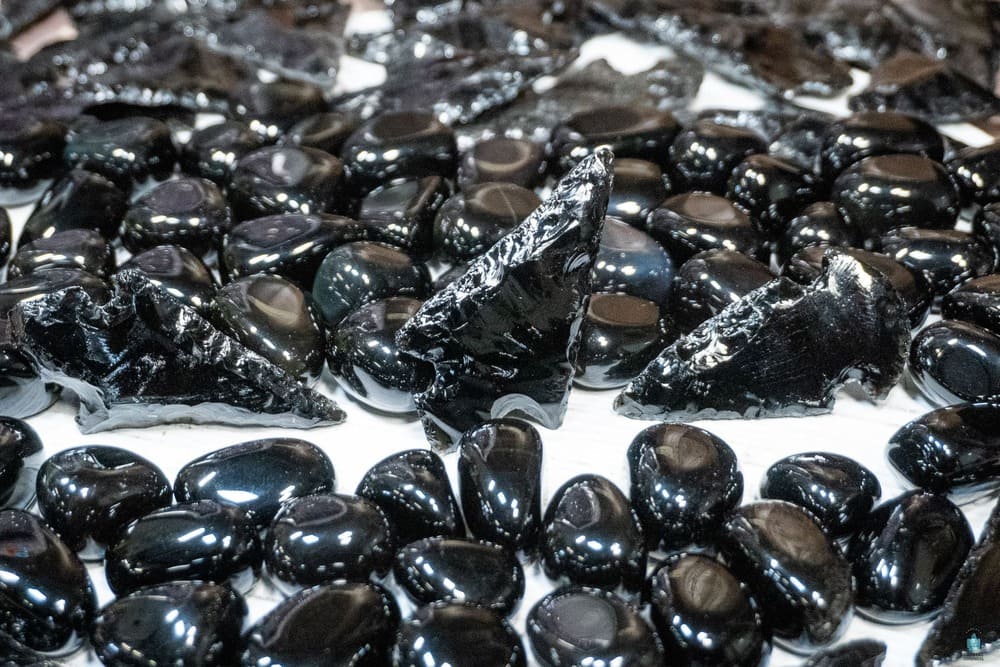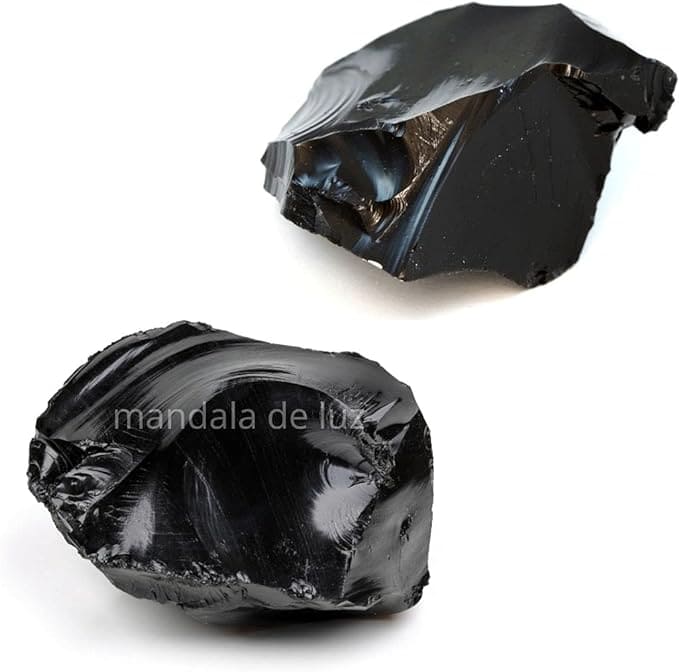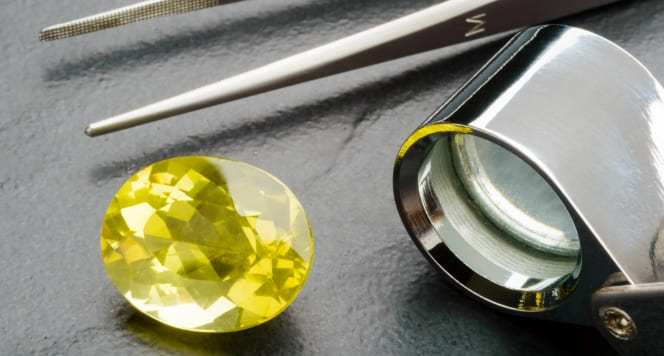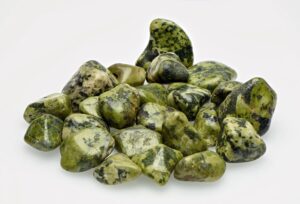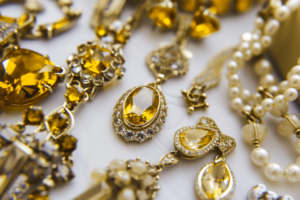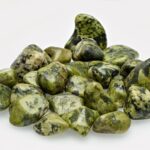In the mystical and ancient atmosphere of obsidian, we dive into the depths of a guide that unlocks the secrets of this fascinating gemstone. Obsidian transcends its aesthetic beauty, carrying with it deep meanings and a practical usefulness that permeates many areas of life.
Here we discover a portal to understanding not only obsidian’s unique geological composition, but also the rich cultural and spiritual tapestry that surrounds it. Shrouded in mystery, this volcanic stone reveals itself as more than just a gem, becoming a symbol of power and connection with earthly energies.
Throughout this guide, we will explore the various aspects that make obsidian a unique gem. From its geological origins to the profound meanings attributed to it by ancient civilizations, together we will uncover the magic that surrounds this unique stone.
Get ready for a journey beyond the ordinary, where every facet of obsidian reveals secrets that will transcend your expectations. Come with us to discover how this extraordinary stone can enrich your life in ways that go beyond the surface.
Ready to explore the mysteries of obsidian? Read on and discover the complete guide to its meanings and uses that we’ve prepared for you.
What is Obsidian?
Obsidian, with its origins deeply rooted in volcanic processes, is an igneous rock with a glassy texture and shiny appearance. Formed from the rapid cooling of lava, this unique stone reveals a history of transformation and extreme heat.
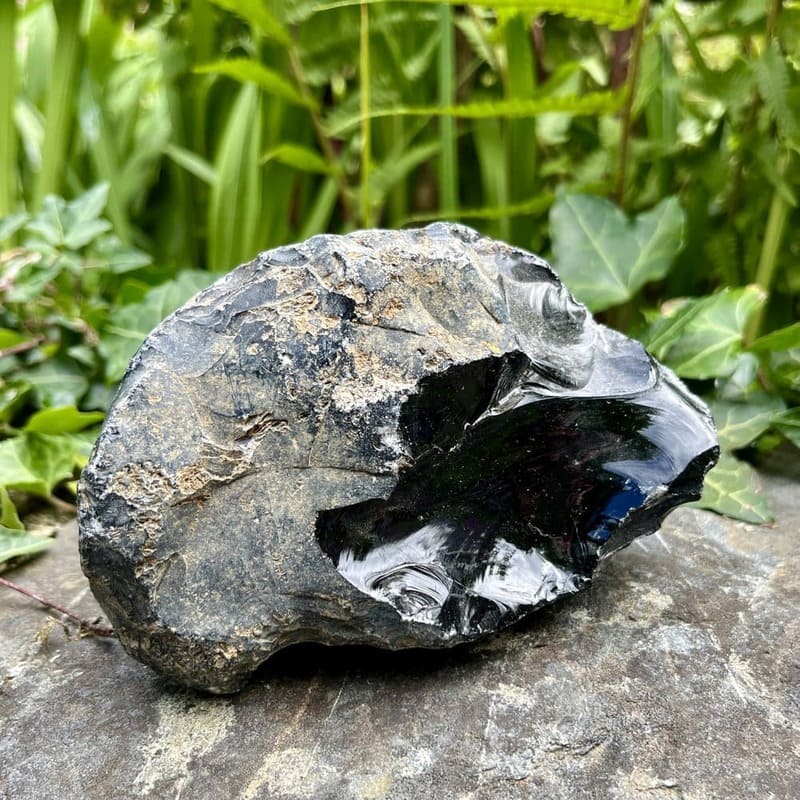
Definition and Origin:
Obsidian, often called “volcanic glass”, stands out for its non-crystalline nature. Its name derives from the Roman Obsius, who supposedly discovered it in Ethiopia. Volcanic eruptions produce lava rich in silica, and its rapid cooling results in the formation of obsidian.
Varieties and characteristics:
- Black Obsidian: The most common variety, known for its intensely dark color.
- Green Obsidian: With shades ranging from dark to light green, this variant adds a unique quality to the color palette.
- Snowflake Obsidian: Includes white or colored crystals, adding a unique visual dimension.
- Golden Obsidian or Mahogany: Features brown or golden tones, adding warmth to its aesthetic.
- Rainbow Obsidian: Ref lects iridescence, providing a spectacle of colors when exposed to light.
These varieties stand out for their distinctive characteristics, offering a wide range of choices for gemstone enthusiasts and collectors. Obsidian transcends its volcanic origin, becoming a remarkable expression of the beauty that can emerge from natural chaos.
By understanding the definition and origin of obsidian, we delve into the geological complexities that have shaped it. Now it’s time to explore the rich histories and cultural meanings that make this stone so fascinating. Continue your journey to unravel the mysteries of obsidian!
In brief:
Obsidian is a stone of volcanic origin with various therapeutic and spiritual properties. It is formed when lava with a felsic composition and low water content cools rapidly, resulting in a natural glass with 70% or more silica in its composition35.Some of the main characteristics and benefits of obsidian include:
- Strong protective energy, acting as a shield against negativity, plus energetic influences and attacks24
- Neutralizes negative energies, illuminates personal energy, purifies environments and balances the emotional2
- Connects with the center of the Earth, dissolving negative energies2
- Blocks and breaks black magic and envy attacks2
- Works to heal the soul, calm the mind and stimulate success24
- Helps remove mental stress, tension and emotional blockages4
- Brings mental clarity, eliminates confusion and promotes self-knowledge4
- Stimulates growth on all levels, opening up new horizons4
Black obsidian is the most common, but there are variations with colors such as brown, gold, white (snowflake) and rainbow, depending on the elements present in its formation13. It should be used with respect and caution, especially in extreme situations.1 To use obsidian, place it on one of the lower chakras (basic, sacral or solar plexus) to attract energies from the higher chakras. Use it for up to 20 minutes, 1-2 times a week1. It is also used as a powerful protective amulet4.
Gostou do artigo? Saiba mais no nosso e-book O Guia Definitivo sobre Pedras Preciosas!
History and Meaning:
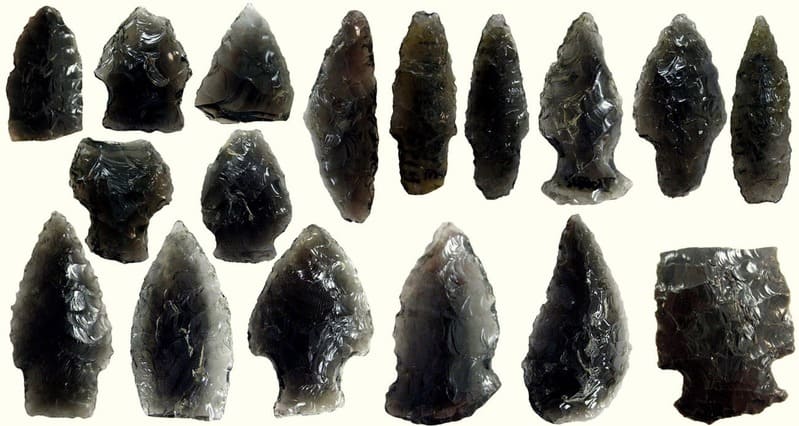
Historical Roots of Obsidian in Different Cultures:
Obsidian has a marked presence in the histories of several ancient civilizations, being appreciated not only for its beauty, but also for its mystical properties. Its use dates back to time immemorial, when peoples such as the Mayans and Aztecs considered it a gift from the gods. In ancient times, it was often carved into tools, weapons and protective amulets.
- In Egypt, obsidian was valued as a protective stone, especially during funerary rituals.
- In Ancient Rome, it was often carved into magical divination mirrors.
Spiritual and Symbolic Meanings Associated with the Stone:
Obsidian transcends its practical usefulness, being intrinsically linked to deep spiritual meanings. Its vivid and mysterious nature inspires beliefs that span generations.
- Energy Protection: Obsidian is considered a shield against negative energies, absorbing and dissipating tensions.
- Inner Transformation: Associated with introspection, it helps to break negative patterns and promote self-knowledge.
- Earthly Connection: Linked to the elements of the Earth, obsidian symbolizes stability and rootedness.
To explore the historical roots of obsidian is to embark on a journey through ancient cultures, revealing how this stone played a vital role in spiritual narratives and everyday practices. To delve into the meanings attributed to it is to open doors to understanding its continuing influence on our understanding of the spiritual and metaphysical world. Read on to uncover more layers of this fascinating story and discover how obsidian remains a bridge between past and present.
Types of Obsidian and Their Properties:
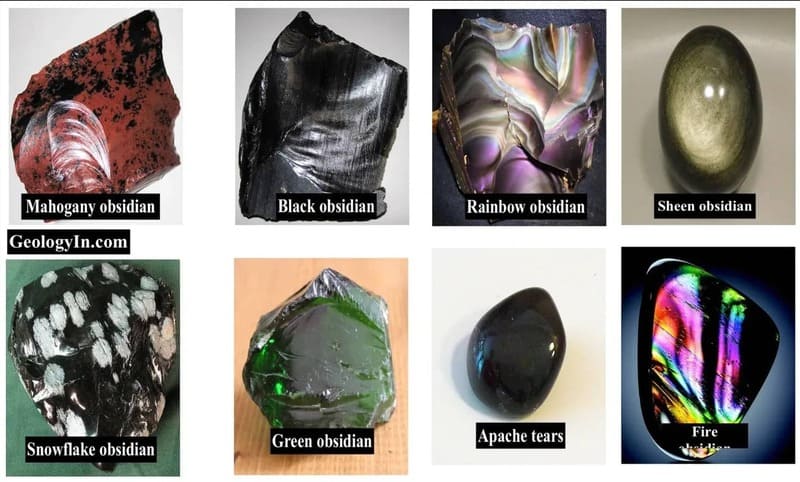
Exploring the Different Variations:
Obsidian unfolds in a variety of types, each with unique visual and energetic characteristics. By exploring these variations, we discover a rich spectrum of expressions of the volcanic nature of this gemstone.
- Black Obsidian: The most common, known for its dark hue and protective properties.
- Green Obsidian: Deep shades ofgreen connect with healing and emotional balance.
- Snowflake Obsidian: White or coloured inclusions create unique patterns, symbolizing purity and transformation.
- Golden Obsidian (Mahogany): With brown or golden tones, this variant warms and strengthens.
Metaphysical and Energetic Properties Associated with Each Type:
- Black Obsidian:
- Energetic Protection: Absorbs negative energies, providing a protective shield.
- Emotional Balance: Helps with emotional stability and coping with challenges.
- Green Obsidian:
- Healing of Body and Mind: Associated with physical and mental renewal and balance.
- Connection with Nature: Strengthens the connection with the energies of the Earth and promotes environmental healing.
- Snowflake Obsidian:
- Inner Purity: Inspiresinner purification and positive transformation.
- Energetic Balance: Helps to harmonize the surrounding energies.
- Golden Obsidian (Mahogany):
- Strength and Confidence: Strengthens self-confidence and determination.
- Inner Warmth: Brings warmth and vitality to spirituality.
By understanding the different variations of obsidian and their distinct properties, you can choose the one that best resonates with your needs and intentions. Obsidian is not just a stone; it is an energy guide, offering a range of benefits that transcend aesthetics. Continue exploring this guide to deepen your connection with obsidian and its incredible metaphysical potential.
Practical Uses of Obsidian:
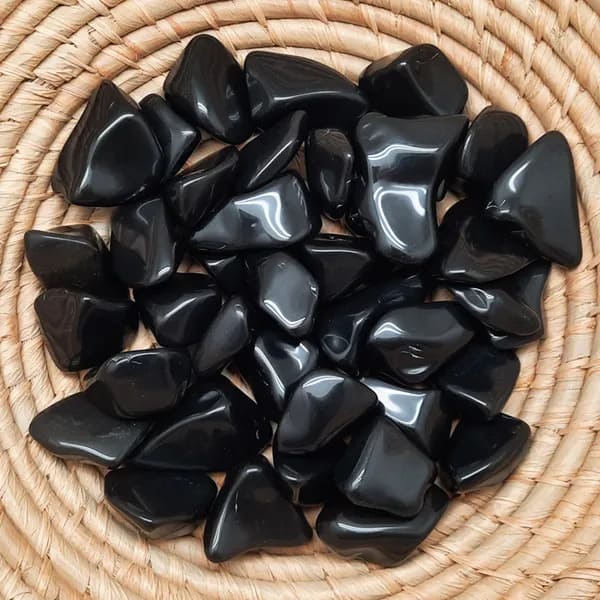
Ancient and Modern Tools Made with Obsidian:
Obsidian, with its sharp nature and hardness, was historically used to make cutting tools. These tools played a vital role in the daily activities of many ancient cultures.
- Blades and arrowheads: Used by civilizations such as the Native Americans for hunting and defence.
- Cutting tools: In ancient times, Mesoamerican peoples produced sharp knives and blades for various purposes.
How Obsidian is Used in Jewelry and Decoration:
Obsidian’s unique beauty has not gone unnoticed in the world of contemporary jewelry and decoration. Its glassy texture and deep hues make it an elegant and meaningful choice.
- Necklaces and Pendants: Obsidian pieces are popular due to their spiritual and aesthetic properties.
- Sculptures and Decorative Objects: Obsidian is carved into beautiful pieces that add a sophisticated touch to interior spaces.
Practical Applications in Rituals and Spiritual Practices:
Obsidian plays a crucial role in rituals and spiritual practices, and is considered a powerful tool for those seeking deeper connections and inner transformations.
- Protective Shields: Used to create energetic barriers and protect against negative influences.
- Meditation and Energy Cleansing: Used to purify the mind and environment during spiritual practices.
By integrating obsidian into various spheres of life, from primitive tools to contemporary jewelry pieces, we see how this versatile stone continues to play a significant role in our spiritual and aesthetic journey. By adopting obsidian in our daily practices, we honor the rich historical tradition and celebrate its timeless properties. Keep exploring to find out more about how to incorporate obsidian into your own path of spiritual growth.
Mental and Emotional Health Benefits:

Exploring Studies and Beliefs about the Positive Effects on Mental Health:
Contemporary studies and ancient beliefs converge in recognizing the positive impacts of obsidian on mental health. Its influence transcends the aesthetic, promoting emotional balance and well-being.
- Scientific Studies: Research indicates that obsidian can help reduce stress and promote emotional stability.
- Holistic Approaches: Practices such as traditional Chinese medicine attribute to obsidian properties that benefit the balance of energy meridians.
Meditation and Healing Techniques with Obsidian:
Obsidian, with its rooting nature, has become a valuable tool in meditation and healing practices. Its presence helps to center the mind and release emotional tensions.
- Contemplation Meditation: Holding an obsidian during meditation can intensify the connection with the present moment.
- Energy Healing: Used in energy therapies, obsidian is placed on specific points to facilitate the release of emotional blockages.
Testimonials from people who have experienced the benefits:
People around the world share transformative experiences of incorporating obsidian into their lives. These testimonials highlight the stone’s versatility in addressing various mental and emotional issues.
- Testimonials of Inner Calm: Many report a sense of serenity and equanimity after interacting with obsidian.
- Experiences of Self-Knowledge: Testimonials highlight how the stone can be a powerful ally on the path to self-knowledge and personal growth.
As we delve into the mental and emotional health benefits of obsidian, we realize that this gemstone goes beyond its physical beauty to become a valuable ally in cultivating inner peace and emotional balance. Keep exploring to discover how obsidian can become a vital element in your own journey of self-care and well-being.
Choosing Your Obsidian: A Step-by-Step Guide:
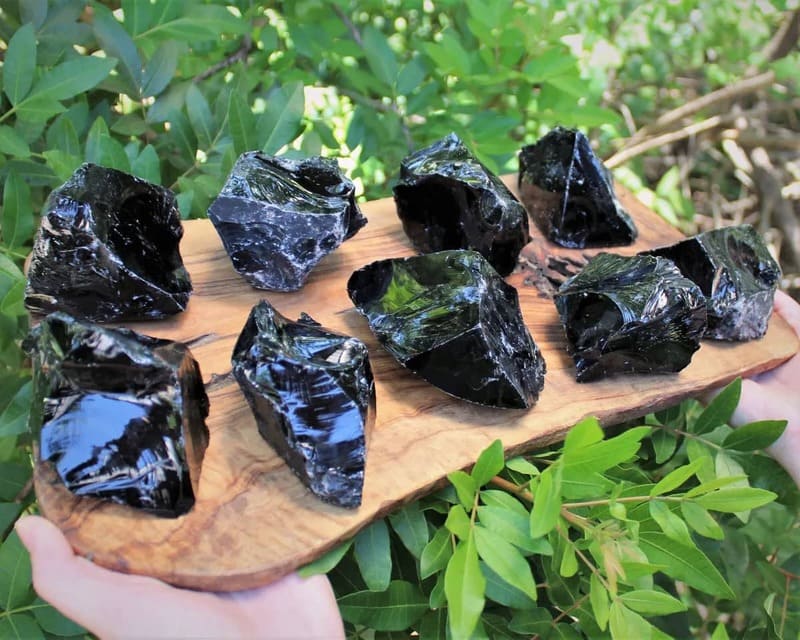
Tips for Selecting the Right Obsidian for Your Needs:
When choosing your obsidian, consider your intentions and goals. The specific characteristics of each variety can offer unique benefits.
- Reflect on Purpose: Identify whether you are looking for protection, emotional healing, or energetic balance.
- Study the Varieties: Learn about the specific properties of black, green, snowflake, etc. obsidian.
- Intuition in Choosing: Tunein to the stone and let your intuition guide your selection.
Cautions and Considerations when Buying Obsidian Jewelry:
When investing in obsidian jewelry, pay attention to details that guarantee authenticity and quality, ensuring that the piece meets your expectations.
- Provenance: Choose obsidian pieces from reliable and ethical sources.
- Lapidary quality: Check the precision of the lapidary to ensure the beauty and durability of the jewel.
- Natural Inclusions: Some varieties, such as snowflake obsidian, may have inclusions that add character to the piece.
Importance of Personal Connection when Choosing a Stone:
Obsidian is a stone that resonates uniquely with each individual. The choice should go beyond the physical properties, involving a personal and energetic connection.
- Touch and Feel: Hold the obsidian, feel its texture and allow its energy to resonate with yours.
- Intuitive reactions: Observe your emotional reactions when coming into contact with different varieties.
- Personal Symbology: Consider colors, shapes and patterns that have personal meanings.
By following this guide, you don’t just acquire a gemstone, you establish a meaningful connection with obsidian. Whether you’re choosing jewelry or a rough piece, allow this unique stone to be a personal expression of your intentions and aspirations. Keep exploring to uncover the mysteries and possibilities that obsidian holds for you.
Curiosities and Myths:
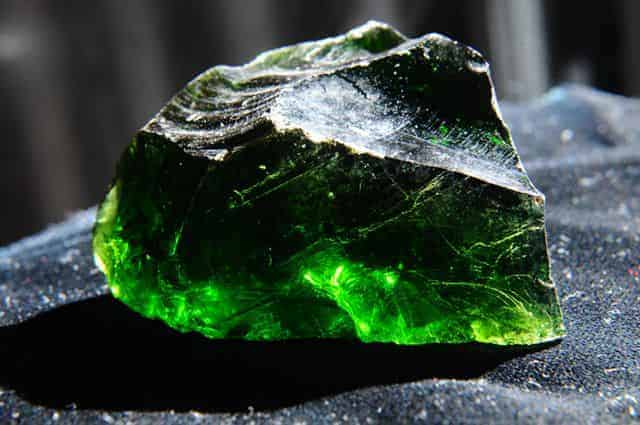
Interesting anecdotes about obsidian:
Obsidian, with its long history and fascination, is full of curiosities that reveal unique aspects about this extraordinary stone.
- Ancient Weapon: In ancient times, obsidian was used to create cutting tools and weapons due to its sharp edge.
- Stone of Protection: Some believe that having a small piece of obsidian in the house protects against negative energies.
Cultural Myths and Stories Related to the Stone:
Different cultures have attributed meanings and myths to obsidian, adding layers of depth to their overall narrative.
- Aztecs and Obsidian Mirrors: The Aztecs used polished obsidian as mirrors, associating it with clear vision and spiritual reflection.
- Mayan Creation Myth: In Mayan mythology, obsidian was considered the blood of the corn god and was used in sacrificial rituals.
These anecdotes and myths reveal the diversity of meanings and uses that have been attributed to obsidian over the centuries. From essential tool to symbol of spiritual power, this stone continues to play intriguing roles in diverse cultures and traditions. Keep exploring to uncover more mysteries and curiosities surrounding obsidian and enrich your understanding of this unique stone.
Conclusion:
By unraveling the mysteries of obsidian, we reveal a beauty that transcends appearances. This stone, rich in history and meaning, is not only an aesthetic treasure, but a powerful ally for those who explore its secrets.
Whether you’re a gemstone enthusiast in search of unique varieties, a spiritual practitioner attuned to its metaphysical properties, or simply someone in search of positive energies, obsidian stands out as a meaningful choice.
As you begin your journey with this unique stone, allow yourself to dive into the intriguing world of obsidian. Explore its variations, understand its properties and tune in to its unique energy. Let every facet of obsidian be an opportunity to deepen your connection with yourself and with the forces that transcend the visible.
Obsidian is not just a rock; it is a silent witness to ancient volcanic eruptions, an artistic expression of nature, and a valuable tool on spiritual journeys. May your journey with obsidian be filled with discovery, personal growth and a deeper understanding of the beauty that resides in the mysteries of the Earth. Let obsidian be your guide on a fascinating path of self-knowledge and exploration.
This comprehensive guide to obsidian offers a deep dive into its mysteries and uses. If you have found value and inspiration in this exploration, consider sharing this article with other enthusiasts, spiritual friends or those seeking the unique beauty of obsidian.
Sharing knowledge is a powerful way to expand awareness and promote appreciation for gemstones like obsidian. By spreading the word about this guide, you contribute to the dissemination of valuable information and help build a community interested in the riches hidden in the wonders of the Earth.
Share this guide and let the magic of obsidian touch lives around you.
Frequently Asked Questions about Obsidian: Unravel the Mysteries and Discover Essential Answers!
- What is obsidian used for?
Obsidian is used for spiritual protection, self-knowledge and energy balance. - What is the power of obsidian?
The power of obsidian includes warding off negative energies, promoting mental clarity and stimulating spiritual growth. - Is there obsidian in Brazil?
Yes, there are deposits of obsidian in Brazil, especially in the central region and in volcanic areas. - Can you sleep with obsidian?
Yes, sleeping with obsidian can intensify spiritual protection and promote more restful sleep. - How do I know if obsidian is real?
Check its authenticity by observing its glassy texture, natural colors and light-reflecting properties. - Where is obsidian found in Brazil?
Obsidian deposits are found in places like Pirenópolis (GO) and other volcanic regions. - Can you wet obsidian?
Yes, obsidian can be wet without damage, but drying it properly is recommended. - Where is obsidian found?
Obsidian is found in volcanic areas around the world, such as Mexico, the USA and Turkey. - How do I recharge black obsidian?
Recharge it by exposing it to indirect sunlight or the light of a full moon for a few hours. - What is the difference between black tourmaline and obsidian?
Both are protective, but black tourmaline absorbs, while obsidian dissipates negative energies. - Where should obsidian be used?
Use obsidian in work environments, meditation, or as jewelry for ongoing benefits. - What is obsidian’s chakra?
Obsidian is mainly associated with the root chakra, strengthening the connection with the earth. - What is the difference between onyx and obsidian?
Both are volcanic, but obsidian is volcanic glass, while onyx is a variety of chalcedony. - How do I clean and energize black obsidian?
Clean it with water and coarse salt, and energize it in the sun or moonlight. - What is the meaning of black obsidian?
Black obsidian symbolizes protection, transformation and the revelation of hidden truths. - How much does a piece of obsidian cost?
The price varies, but small pieces can cost from a few reais, while larger pieces can be more expensive. - How is obsidian made?
Obsidian is formed naturally during volcanic eruptions when lava cools quickly. - What types of obsidian are there?
There are several varieties, such as black, snowflake, rainbow and golden, each with different characteristics. - How to purify black obsidian?
Purify it with running water, coarse salt or by leaving it under moonlight or sunlight. - What is the power of black obsidian?
Black obsidian is powerful for protection, dissipating negative energy and promoting self-knowledge. - What is the black obsidian mirror used for?
The black obsidian mirror is used for spiritual reflection, amplifying intuitions and energetic protection. - What is black obsidian?
Black obsidian is a glassy volcanic stone known for its protective and spiritual properties. - How to wear black obsidian?
Wear it as jewelry, in meditation, or carry it around to benefit from its protective properties. - How to clean black obsidian?
Clean it with running water and purify it with methods such as coarse salt. - How to energize black obsidian?
Energize it in the sun or moonlight for a few hours to enhance its properties.
Sources:


